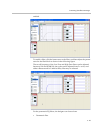
Customizing SoundStructure Designs
5 - 33
group.
References can be selected from any output signal or from any submix signal.
A reference can be either a mono virtual channel or a stereo virtual channel. If
only a single mono virtual channel reference is specified, the system is operat-
ing as a monaural echo canceller. If either a stereo virtual channel or two mono
virtual channels are specified, the system is operating as a stereo echo
canceller.
References should consist of all the remote audio that is being played into the
local room including telephony signals, video codec signals, and program
audio.
Noise Cancellation
The noise cancellation processing is available on all analog inputs via the con-
ferencing and sound reinforcement processing paths. The noise cancellation
reduces background noise that is picked up by microphones or already
present in input signals from program audio sources. The noise cancellation
functionality can be turned on or off with the enable button. The amount of
noise cancellation can be adjusted from 0 to 20 dB.
The SoundStructure noise cancellation will effectively remove different types
of background noise ranging from narrow band noise (e.g., tones) to broad-
band noise. For best performance, the noise characteristics should be
quasi-stationary, for example, the statistics of the underlying noise are fixed or
change slowly over time.
Noise cancellation can be enabled for a non microphone channel, such as a
video codec audio or program audio, by selecting the conferencing version of
the ungated signal path (note that the default selection for non-microphone
audio sources is the line-input processing path). The ungated conferencing
signal path is shown in the following figure. Notice that the noise cancellation
processing is now in the signal path along with the automatic gain control,
Any output signal or submix signal can be used as an echo canceller reference.
The reference should include all remote audio sources.


















